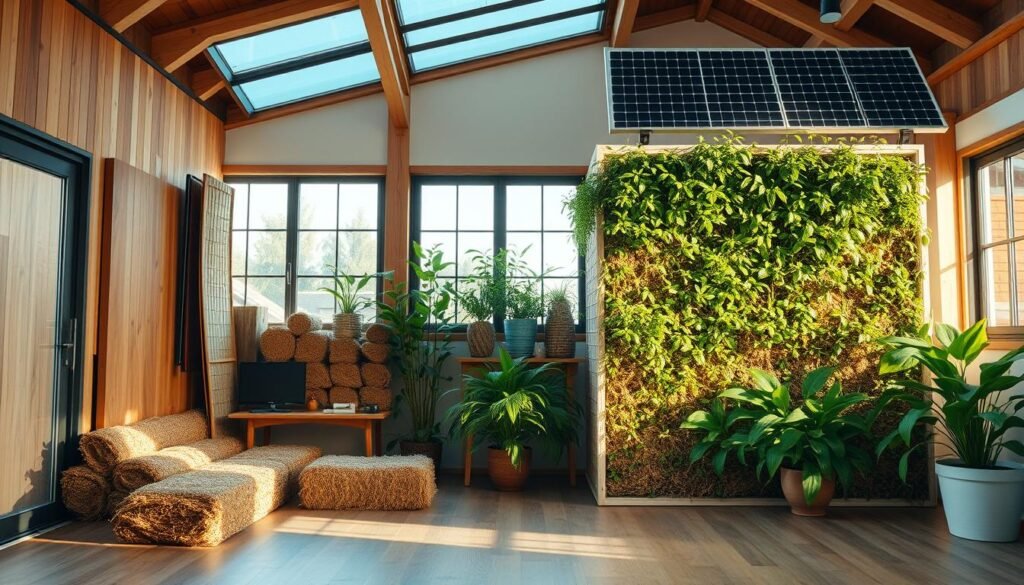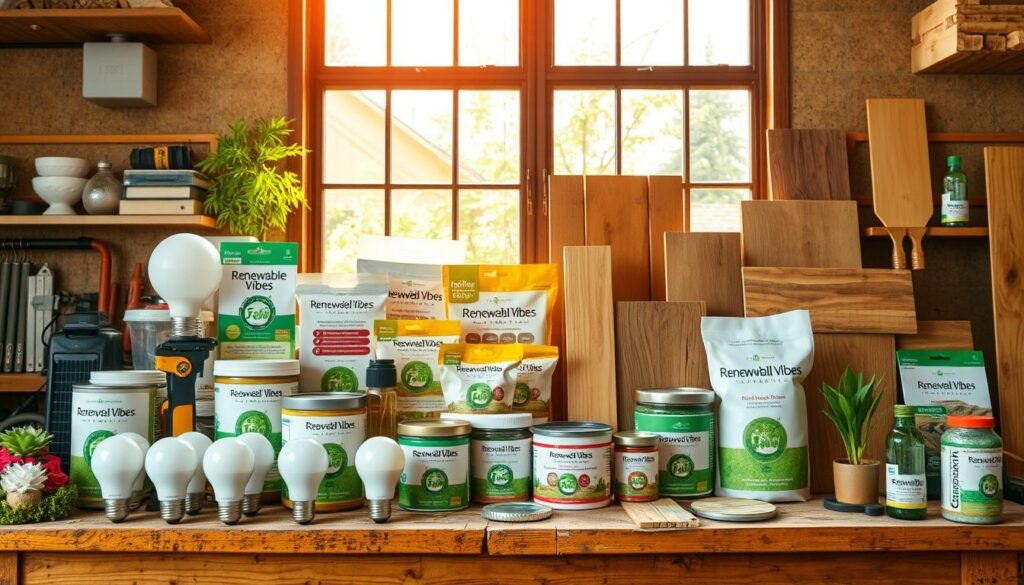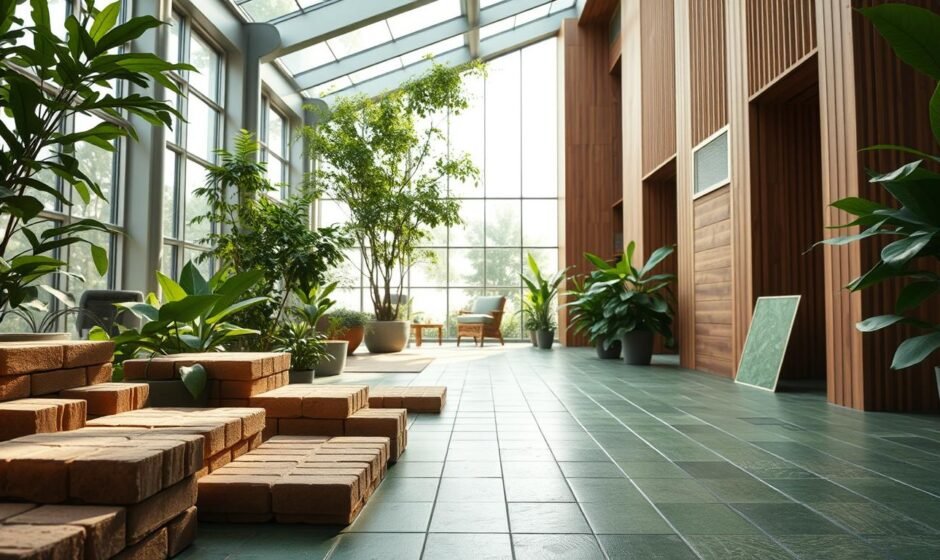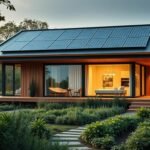Building or renovating your home is a chance to help the environment. Climate change makes it vital to think about our building choices. Using green materials can cut down on carbon emissions and make your home healthier.
Choosing sustainable materials can save money, with costs dropping by 21-23% in a year and 43-49% in five. Materials like bamboo, wool, and cork keep your home warm or cool without needing much energy. Also, green building cuts down on waste, with 30% less waste in traditional construction.
Key Takeaways
- Incorporating green building materials for eco-conscious homes can reduce your carbon footprint and create a healthier living space.
- Sustainable construction materials, such as bamboo and wool, provide excellent insulation and can lead to reduced operating costs.
- Eco-friendly building supplies, like cork and recycled plastic, can reduce waste and promote energy efficiency.
- Sustainable building practices can lead to a significant reduction in waste and energy consumption.
- Using sustainable construction materials can lead to reported decreases of 21-23% in the first 12 months and 43-49% within five years.
- Green building materials for eco-conscious homes are essential for creating a sustainable and environmentally friendly living space.
- Sustainable construction materials and eco-friendly building supplies are critical for reducing the environmental impact of our building choices.
What Are Green Building Materials?
Thinking about building or renovating your home? You might wonder about the materials to use. Environmentally friendly construction materials are gaining popularity. They have a lower environmental impact and can be reused or recycled.
Choosing sustainable building products can cut down energy use and make your home healthier. Materials like bamboo, recycled steel, and hempcrete are great examples. They’re eco-friendly and last a long time.
Here are some benefits of using green building materials:
- Reduced energy consumption
- Lower environmental impact
- Improved indoor air quality
- Increased durability and longevity
By picking environmentally friendly construction materials, you help the planet. The construction industry wants to cut emissions by 45% by 2030. Using green home materials is a big step towards that goal.
| Material | Benefits |
|---|---|
| Bamboo | Rapidly renewable, low carbon footprint |
| Recycled Steel | Reduced energy consumption, lower environmental impact |
| Hempcrete | Carbon sequestration, excellent insulation properties |
Key Characteristics of Sustainable Building Materials
Building an eco-conscious home means choosing materials that are good for the planet. These materials should help save energy, last long, and keep the air inside clean. They should also cut down on waste and make your home healthier.
Good insulation and air tightness are key. Materials like cellulose insulation, made from 75-85% recycled paper, are great. They have an R-value of 3.5-3.8 per inch. Mineral wool insulation, with 75% recycled content, also works well, with an R-value of 4-4.5 per inch.
Energy Efficiency
Energy efficiency is vital in sustainable building. It helps save energy and reduces waste. Bamboo, which grows fast, is a good choice. It reaches maturity in just three to five years.
Reclaimed wood is another option. It comes from old barns, remodeling projects, and more. It’s a sustainable choice that adds character to your home.
Durability and Longevity
Durability and longevity are important too. Materials like terrazzo flooring can last up to 40 years with care. Clay bricks help keep your home warm in winter and cool in summer.
Plant-based polyurethane foam is also durable. It’s resistant to heat and mold, making your home more comfortable without harming the environment.
- Cellulose insulation
- Mineral wool insulation
- Bamboo
- Reclaimed wood
- Terrazzo flooring
- Clay bricks
| Material | R-value | Recycled Content |
|---|---|---|
| Cellulose insulation | 3.5-3.8 per inch | 75-85% |
| Mineral wool insulation | 4-4.5 per inch | 75% |
| Bamboo | N/A | N/A |
Popular Green Building Materials for Your Projects
Choosing the right materials for your home is key. You want them to be durable, energy-efficient, and good for the planet. Materials like bamboo, recycled steel, and hempcrete are gaining popularity for these reasons.
These materials help cut down on carbon emissions and improve air quality inside. Options like reclaimed wood and low-carbon concrete also support a greener future.
Bamboo
Bamboo grows fast, maturing in 3 to 5 years. It’s a top pick for green building, absorbing lots of carbon dioxide.
Recycled Steel
Recycled steel is a hit, with 40% of steel made from recycled materials. It cuts down on waste and saves virgin materials.
Hempcrete
Hempcrete uses hemp fibers, lime, and water. It’s a great insulator, saving energy and improving air quality.
Using these materials can lower your carbon footprint. Look for local suppliers and check for certifications to meet your standards.
Benefits of Using Eco-Friendly Building Products
Building your dream home means it should be beautiful and good for the planet. Eco-friendly building products help a lot. They cut down on energy use and waste. Using environmentally sustainable building materials makes your home healthier for you and your family.
Using eco-friendly products has many benefits. They cut down on harmful gases, improve air quality, and save energy. For instance, materials like bamboo, recycled steel, and hempcrete can save 30-50% on heating and cooling costs. Also, using eco-friendly building supplies like low-VOC paints can reduce indoor pollution by up to 60%.
Here are some key statistics that highlight the benefits of using eco-friendly building products:
- Eco-friendly building materials can reduce greenhouse gas emissions by up to 50% compared to traditional building materials.
- Incorporating high-performance insulation can lower energy consumption for heating and cooling by approximately 30-50%.
- Using recycled steel can decrease the carbon footprint by 74% compared to producing new steel.
Choosing eco-friendly building supplies helps the planet and makes your home healthier. So, why not switch to green building materials for eco-conscious homes and build a better future today?
| Material | Benefits |
|---|---|
| Bamboo | Highly renewable, durable, and resistant to pests and decay |
| Recycled Steel | Reduced carbon footprint, durable, and resistant to corrosion |
| Hempcrete | Insulating, fire-resistant, and pest-resistant |
Strategies for Sourcing Green Materials
Building an eco-home means finding sustainable construction materials. Look for local suppliers of eco-friendly building supplies. This helps cut down on transport costs and boosts the local economy.
Check for labels like FSC or PEFC on materials. These labels mean the green home materials are sourced responsibly. Natural options, like sheep’s wool insulation, are also great. They keep your home warm and are a renewable resource.
Using green materials has many advantages:
- It reduces harm to the environment
- It improves the air inside your home
- It makes your home more energy-efficient
- It supports local businesses
By picking sustainable construction materials and eco-friendly building supplies, you make a green home. It’s good for the planet, saves money, and is healthier to live in.
| Material | Benefits |
|---|---|
| Bamboo | Renewable, durable, and low maintenance |
| Recycled Steel | High strength, low carbon footprint, and recyclable |
| Hempcrete | Insulating, breathable, and sustainable |
Designing with Sustainability in Mind
When designing your eco-conscious home, it’s key to use green building materials and sustainable supplies. These choices help reduce your home’s environmental impact. For example, using reclaimed wood and bricks adds uniqueness while cutting down on waste.
Maximizing natural light and using thermal mass are core to sustainable design. This means optimizing your home’s orientation and using materials like concrete or brick. These choices help cut down on artificial lighting and heating, saving energy.

- Using energy-efficient windows and doors to lower heating and cooling costs
- Installing solar panels to produce renewable energy
- Implementing rainwater harvesting systems to reduce water use
By using these sustainable design elements, you can make an eco-friendly home. It will not only lessen your environmental impact but also offer a healthy and comfy living space.
Case Studies: Successful Eco-Home Projects
Building eco-conscious homes needs eco-friendly building supplies and sustainable materials. The BedZED project in the UK is a great example. It shows how green materials can make homes energy-efficient.
In Australia, Beulah has built ecologically sustainable townhouses in Melbourne. These projects prove the value of eco-friendly building supplies. They’ve cut down energy use and greenhouse gas emissions a lot.
Inspiring Examples
These case studies are great examples of eco-friendly homes. They show how to use green materials in construction. By following their lead, you can make your projects more sustainable and eco-friendly.
Lessons Learned
These studies teach us the importance of green building materials. Using eco-friendly supplies makes homes better for the environment. They’re also energy-efficient and can save money.
Overcoming Challenges in Sustainable Construction
Building an eco-home can face challenges, like the cost of green materials. These materials might be pricier than usual. But, think about the long-term savings and benefits they offer.
Ways to tackle these issues include finding local materials and using recycled ones. You can also design your home to use less. For example, using bamboo or recycled steel cuts down on waste and saves resources.

It’s important to compare the costs and benefits of green materials. Look at their energy use, how long they last, and upkeep needs. Choosing the right materials can make your home eco-friendly and save you money in the long run.
Key steps to overcome construction challenges include:
- Checking the cost and availability of sustainable materials
- Looking for local suppliers
- Designing to reduce waste and environmental impact
The Future of Green Building Materials
Thinking about building or renovating your home? You’re probably looking into the right materials. The need for eco-friendly building supplies is rising. It’s key to check out the newest environmentally sustainable building materials.
The global market for green building materials is set to hit $1,234 billion by 2027. It will grow at a 12.4% CAGR from 2020 to 2027.
Innovations on the Horizon
New trends are coming in the construction world. Green building materials for eco-conscious homes are becoming more popular. Bamboo, hempcrete, and recycled steel are seeing more use.
The market for sustainable insulation is also growing. It’s expected to reach $9.6 billion by 2026. This includes materials like cellulose and spray foam.
Trends to Watch
Here are some trends to keep an eye on for green building materials:
- More use of recycled materials, with 59% of builders using more of them
- More people want energy-efficient homes, with 61% of homeowners preferring them
- New sustainable materials like bioplastics and low-carbon concrete are emerging
How to Get Started with Your Eco-Home
Starting your sustainable home journey requires careful planning and expert advice. First, look into eco-friendly building materials that fit your project’s needs. This includes focusing on energy efficiency and reducing environmental impact. Talk to local suppliers to find out what sustainable materials are available for your green home.
Working with experienced sustainable construction professionals is a big plus. They bring knowledge on sustainable design, material choice, and building methods. Their help can make your dream of an eco-friendly, energy-saving home a reality.





Unlock Savings with Energy-Efficient Building Retrofits 12 Feb 2025
[…] more info on sustainable building, visit Renewable Vibes. They cover the latest in environmentally conscious […]